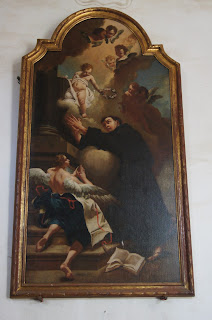Of all the missions in California, La Purisima in Lompoc is the most extensively restored. It is an open air museum and very child-friendly. The visitor's center is large and well documented with lots of illustrated posters making it easy for children to read and understand. When I was there last week, a little boy ran up to me and told me he had just fed the horses some carrots. "I love this place," he beamed. There are cattle, pigs, sheep and horses in the fields. Hiking trails throughout the park lead you to a reed Chumash village, a blacksmith shop, the mission gardens and a picnic area.
The mission was founded in 1787 and covered 470 square miles. Twenty thousand cattle and sheep roamed the fields surrounding it, so this particular mission was known for its hides and its beautiful Indian blankets. These were exchanged for goods from the Mexican supply ships. Because it is a state historic park and not an active Catholic parish, the exhibits did not have that religious skew that some of them have. I began to understand just how difficult life must have been for the Chumash who were forced into labor to keep the missions running. Yes, they learned new trades but smallpox and measles wiped whole populations out. Few children lived past the age of five.
"Regardless of the intent of the missionaries, the results were devastating to Native Americans. Their populations declined drastically and the survivors lost a great deal of their culture."
The California missions were part of the Spanish Empire's growing colonization of the Americas. They believed that a baptized Native American could be more easily molded into their society. Every mission had two padres in charge: one for administrative tasks and the other for spiritual concerns.
I spent two hours wandering in and out of the rooms and hiking the trails. It gives a fascinating glimpse into mission life, for better or for worst. Besides the main altar, you can see the soldiers' barracks, the apartments of the priests, the kitchens, weaving room, candle making room and much more.
When secularization occurred, the mission was carved up into many different ranches and over the years, they changed hands several times. By the 1930's La Purisima was a pile of ruins. During Roosevelt's New Deal, the Civilian Conservation Corp restored the buildings and the grounds. Its a beautiful setting and a great way to spend an afternoon.






 I
I 




No comments:
Post a Comment